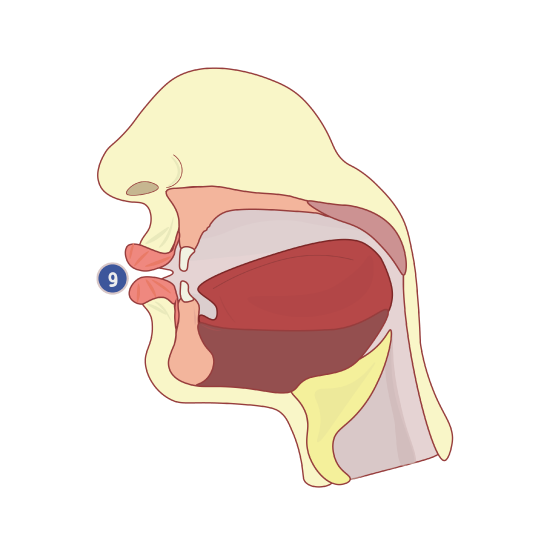4.2: Letter Waw- الحرف واو
- Page ID
- 260237
\( \newcommand{\vecs}[1]{\overset { \scriptstyle \rightharpoonup} {\mathbf{#1}} } \)
\( \newcommand{\vecd}[1]{\overset{-\!-\!\rightharpoonup}{\vphantom{a}\smash {#1}}} \)
\( \newcommand{\dsum}{\displaystyle\sum\limits} \)
\( \newcommand{\dint}{\displaystyle\int\limits} \)
\( \newcommand{\dlim}{\displaystyle\lim\limits} \)
\( \newcommand{\id}{\mathrm{id}}\) \( \newcommand{\Span}{\mathrm{span}}\)
( \newcommand{\kernel}{\mathrm{null}\,}\) \( \newcommand{\range}{\mathrm{range}\,}\)
\( \newcommand{\RealPart}{\mathrm{Re}}\) \( \newcommand{\ImaginaryPart}{\mathrm{Im}}\)
\( \newcommand{\Argument}{\mathrm{Arg}}\) \( \newcommand{\norm}[1]{\| #1 \|}\)
\( \newcommand{\inner}[2]{\langle #1, #2 \rangle}\)
\( \newcommand{\Span}{\mathrm{span}}\)
\( \newcommand{\id}{\mathrm{id}}\)
\( \newcommand{\Span}{\mathrm{span}}\)
\( \newcommand{\kernel}{\mathrm{null}\,}\)
\( \newcommand{\range}{\mathrm{range}\,}\)
\( \newcommand{\RealPart}{\mathrm{Re}}\)
\( \newcommand{\ImaginaryPart}{\mathrm{Im}}\)
\( \newcommand{\Argument}{\mathrm{Arg}}\)
\( \newcommand{\norm}[1]{\| #1 \|}\)
\( \newcommand{\inner}[2]{\langle #1, #2 \rangle}\)
\( \newcommand{\Span}{\mathrm{span}}\) \( \newcommand{\AA}{\unicode[.8,0]{x212B}}\)
\( \newcommand{\vectorA}[1]{\vec{#1}} % arrow\)
\( \newcommand{\vectorAt}[1]{\vec{\text{#1}}} % arrow\)
\( \newcommand{\vectorB}[1]{\overset { \scriptstyle \rightharpoonup} {\mathbf{#1}} } \)
\( \newcommand{\vectorC}[1]{\textbf{#1}} \)
\( \newcommand{\vectorD}[1]{\overrightarrow{#1}} \)
\( \newcommand{\vectorDt}[1]{\overrightarrow{\text{#1}}} \)
\( \newcommand{\vectE}[1]{\overset{-\!-\!\rightharpoonup}{\vphantom{a}\smash{\mathbf {#1}}}} \)
\( \newcommand{\vecs}[1]{\overset { \scriptstyle \rightharpoonup} {\mathbf{#1}} } \)
\( \newcommand{\vecd}[1]{\overset{-\!-\!\rightharpoonup}{\vphantom{a}\smash {#1}}} \)
\(\newcommand{\avec}{\mathbf a}\) \(\newcommand{\bvec}{\mathbf b}\) \(\newcommand{\cvec}{\mathbf c}\) \(\newcommand{\dvec}{\mathbf d}\) \(\newcommand{\dtil}{\widetilde{\mathbf d}}\) \(\newcommand{\evec}{\mathbf e}\) \(\newcommand{\fvec}{\mathbf f}\) \(\newcommand{\nvec}{\mathbf n}\) \(\newcommand{\pvec}{\mathbf p}\) \(\newcommand{\qvec}{\mathbf q}\) \(\newcommand{\svec}{\mathbf s}\) \(\newcommand{\tvec}{\mathbf t}\) \(\newcommand{\uvec}{\mathbf u}\) \(\newcommand{\vvec}{\mathbf v}\) \(\newcommand{\wvec}{\mathbf w}\) \(\newcommand{\xvec}{\mathbf x}\) \(\newcommand{\yvec}{\mathbf y}\) \(\newcommand{\zvec}{\mathbf z}\) \(\newcommand{\rvec}{\mathbf r}\) \(\newcommand{\mvec}{\mathbf m}\) \(\newcommand{\zerovec}{\mathbf 0}\) \(\newcommand{\onevec}{\mathbf 1}\) \(\newcommand{\real}{\mathbb R}\) \(\newcommand{\twovec}[2]{\left[\begin{array}{r}#1 \\ #2 \end{array}\right]}\) \(\newcommand{\ctwovec}[2]{\left[\begin{array}{c}#1 \\ #2 \end{array}\right]}\) \(\newcommand{\threevec}[3]{\left[\begin{array}{r}#1 \\ #2 \\ #3 \end{array}\right]}\) \(\newcommand{\cthreevec}[3]{\left[\begin{array}{c}#1 \\ #2 \\ #3 \end{array}\right]}\) \(\newcommand{\fourvec}[4]{\left[\begin{array}{r}#1 \\ #2 \\ #3 \\ #4 \end{array}\right]}\) \(\newcommand{\cfourvec}[4]{\left[\begin{array}{c}#1 \\ #2 \\ #3 \\ #4 \end{array}\right]}\) \(\newcommand{\fivevec}[5]{\left[\begin{array}{r}#1 \\ #2 \\ #3 \\ #4 \\ #5 \\ \end{array}\right]}\) \(\newcommand{\cfivevec}[5]{\left[\begin{array}{c}#1 \\ #2 \\ #3 \\ #4 \\ #5 \\ \end{array}\right]}\) \(\newcommand{\mattwo}[4]{\left[\begin{array}{rr}#1 \amp #2 \\ #3 \amp #4 \\ \end{array}\right]}\) \(\newcommand{\laspan}[1]{\text{Span}\{#1\}}\) \(\newcommand{\bcal}{\cal B}\) \(\newcommand{\ccal}{\cal C}\) \(\newcommand{\scal}{\cal S}\) \(\newcommand{\wcal}{\cal W}\) \(\newcommand{\ecal}{\cal E}\) \(\newcommand{\coords}[2]{\left\{#1\right\}_{#2}}\) \(\newcommand{\gray}[1]{\color{gray}{#1}}\) \(\newcommand{\lgray}[1]{\color{lightgray}{#1}}\) \(\newcommand{\rank}{\operatorname{rank}}\) \(\newcommand{\row}{\text{Row}}\) \(\newcommand{\col}{\text{Col}}\) \(\renewcommand{\row}{\text{Row}}\) \(\newcommand{\nul}{\text{Nul}}\) \(\newcommand{\var}{\text{Var}}\) \(\newcommand{\corr}{\text{corr}}\) \(\newcommand{\len}[1]{\left|#1\right|}\) \(\newcommand{\bbar}{\overline{\bvec}}\) \(\newcommand{\bhat}{\widehat{\bvec}}\) \(\newcommand{\bperp}{\bvec^\perp}\) \(\newcommand{\xhat}{\widehat{\xvec}}\) \(\newcommand{\vhat}{\widehat{\vvec}}\) \(\newcommand{\uhat}{\widehat{\uvec}}\) \(\newcommand{\what}{\widehat{\wvec}}\) \(\newcommand{\Sighat}{\widehat{\Sigma}}\) \(\newcommand{\lt}{<}\) \(\newcommand{\gt}{>}\) \(\newcommand{\amp}{&}\) \(\definecolor{fillinmathshade}{gray}{0.9}\)In this section, you will be able to:
- Read and write و in its different shapes.
- Pronounce the letter و with short and long vowels.
- Learn different functions of the letter و.
Introduction
The letter Waw (و) is a significant character in the Arabic alphabet, known for its versatility and essential role in the language. It is the 27th letter of the Arabic alphabet and is pronounced as /w/ or as a long vowel /uː/. The form of Waw remains consistent regardless of its position within a word—beginning, middle, or end—making it unique among Arabic letters. Beyond its phonetic functions, Waw also serves critical grammatical purposes. Unlike many other Arabic letters, Waw maintains the same shape regardless of its position in a word, making it relatively easy to recognize and write. The letter Waw (و) in Arabic has several important functions that are crucial for understanding and mastering the language. Here are its primary roles:
functions of the Letter Waw
- Consonant Function:
- Waw represents the consonant sound /w/ in words, similar to the English "w." For example, in the word "وردة" (warda), meaning "flower," Waw is pronounced as /w/.
- Long Vowel Function (/uː/):
- Waw also serves as a long vowel, representing the sound /uː/. This is analogous to the English "oo" in "food." For instance, in "نور" (nur), meaning "light," Waw elongates the "u" sound.
- Conjunction ("and"):
- One of the most common uses of Waw is as a conjunction equivalent to "and" in English. It connects words, phrases, and clauses. For example, "كتاب وقلم" (kitab wa qalam) means "a book and a pen."
- Waw with Sukoon (Diphthongs):
- Waw can form diphthongs when combined with other vowels, such as in "سَوْفَ" (sawfa, meaning "will"), where it creates the /aw/ sound.
Understanding these functions of Waw is essential for anyone learning Arabic, as it plays a key role in the language's phonetic, grammatical, and syntactical structures.
The Letter Waw و
Pronunciation of The Letter Waw و
The letter Waw و has two functions like the letter Yaa ي. The first function is as the long vowel و. The second function is as a consonant. The consonant و can be preceded or followed by a long vowel, or it can or carry a short vowel. It is pronounced “w” as in well, howl, or “wh” in what, why, whale.
The articulation point of the letter waw “و” is the two lips, and it is articulated by forming a circle with both lips without them meeting completely, and pointing the lips to the front.

Pronunciation of letter "و" with short vowels الحركات and absence of short vowels السكون.
| The Marks (Harakat الحركات) | The Letter with the mark | Audio |
|---|---|---|
|
Fataha الفتحة |
وَ |
|
|
Dhama الضمة |
وُ |
|
|
Kasra الكسرة |
وِ |
|
|
Absence of short vowel Sukoon السكون |
وْ |
|
Pronunciation of the letter Waw "و" with long vowels
| The Long Vowel المدود | The Letter with a long vowel | Audio |
|---|---|---|
|
The long vowel "ا"=aa |
وا |
|
|
The long vowel "و"= oo/uu |
وو |
|
| The long vowel "ي"=ee/ii | وي |
|
How to write the letter و
The letter و is only connected from one side – the preceding letter – if the preceding letter also has a connector. To write the independent و, begin on the line, make a loop, move clockwise and upwards to the left, and then swing down into the tail, which should dip well below the line.
When writing و in the medial and final positions, begin from the connecting segment, draw a circle of the letter و above the line, and extend the line of و under the line by making a simple curve. (Watch the video)
|
Letter at the End of a Word |
Letter in the Middle of a Word |
Letter at the Beginning of a Word |
Letter Shape |
|---|---|---|---|
| ــو | ــو | و | و |
The video below demonstrates how to write the letter Waw و :
Watch the video to learn more about the letter Waw الحرف واو.

